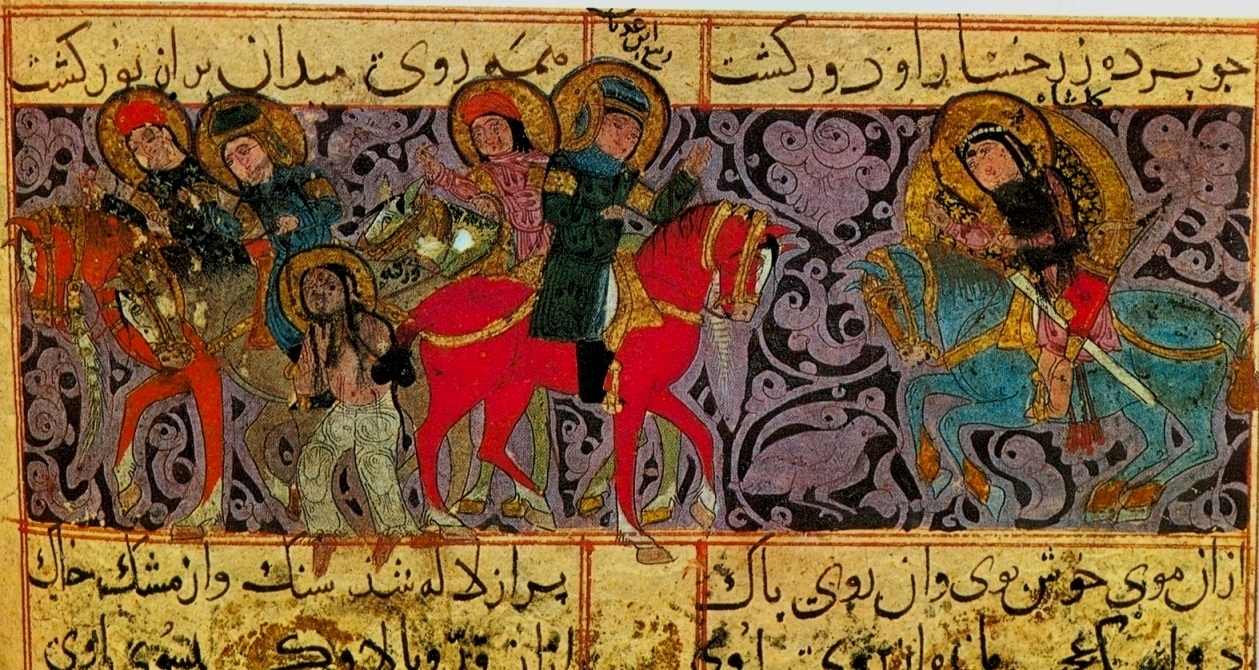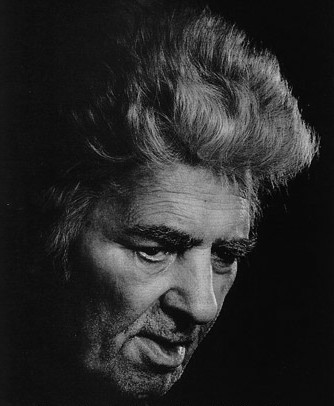|
Ayyuqi
Ayyuqi ( fa, عیوقی) was a 10th-century Persian poet. A contemporary of Mahmud of Ghazni, he wrote the epic ''Varqa wa Golshāh'' () in 2,250 verses, story of the love between a youth named Varqa and a maiden, Golshah. According to the poet himself, the story is based on the Arabic work ''‘Orwa wa ‘Afra''. The work survives in a unique manuscript at Istanbul (''in picture''). He also wrote some ''qasida''s. No reliable information about Ayyuqi has come down.Dj. Khaleghi-Motlagh"ʿAYYŪQĪ" In ''Encyclopædia Iranica''. December 15, 1987. Retrieved February 26, 2012. His works are characterized by paired rhyme interspersed with ghazal. See also *List of Persian poets and authors *Persian literature Persian literature ( fa, ادبیات فارسی, Adabiyâte fârsi, ) comprises oral compositions and written texts in the Persian language and is one of the world's oldest literatures. It spans over two-and-a-half millennia. Its sources h ... References * Jan Rypk ... [...More Info...] [...Related Items...] OR: [Wikipedia] [Google] [Baidu] |
List Of Persian Poets And Authors
The list is not comprehensive, but is continuously being expanded and includes Persian writers and poets from Iran, Afghanistan, Azerbaijan, Bangladesh, India, Tajikistan, Uzbekistan, and Turkmenistan. This list is alphabetized by chronological order. Although a few authors in this list do not have their ethnic origin, nevertheless they have enriched Persian culture and civilization by their remarkable contributions to the rich Persian literature. The modern Persian speaker comprehends the literature of the earliest Persian poets including founder of the Persian poetry and literature Rudaki (approximately 1150 years ago) all the way down to the works of modern Persian poets. Some names that lived during the turn of a century appear twice. From the 7th to the 8th centuries *Abu'l-Abbas Marwazi 9th century * Rudaki (رودکی) * Muhammad al-Bukhari Persian Islamic Scholar, (810 - 870) * Mansur Al-Hallaj (منصور حلاج) * Shahid Balkhi (ابوالحسن شهيدبن حسي ... [...More Info...] [...Related Items...] OR: [Wikipedia] [Google] [Baidu] |
Persian Poetry
Persian literature ( fa, ادبیات فارسی, Adabiyâte fârsi, ) comprises oral compositions and written texts in the Persian language and is one of the world's oldest literatures. It spans over two-and-a-half millennia. Its sources have been within Greater Iran including present-day Iran, Iraq, Afghanistan, the Caucasus, and Turkey, regions of Central Asia (such as Tajikistan) and South Asia where the Persian language has historically been either the native or official language. For example, Rumi, one of the best-loved Persian poets, born in Balkh (in modern-day Afghanistan) or Wakhsh (in modern-day Tajikistan), wrote in Persian and lived in Konya (in modern-day Turkey), at that time the capital of the Seljuks in Anatolia. The Ghaznavids conquered large territories in Central and South Asia and adopted Persian as their court language. There is thus Persian literature from Iran, Mesopotamia, Azerbaijan, the wider Caucasus, Turkey, Pakistan, Bangladesh, India, Tajikista ... [...More Info...] [...Related Items...] OR: [Wikipedia] [Google] [Baidu] |
Mahmud Of Ghazni
Yamīn-ud-Dawla Abul-Qāṣim Maḥmūd ibn Sebüktegīn ( fa, ; 2 November 971 – 30 April 1030), usually known as Mahmud of Ghazni or Mahmud Ghaznavi ( fa, ), was the founder of the Turkic Ghaznavid dynasty, ruling from 998 to 1030. At the time of his death, his kingdom had been transformed into an extensive military empire, which extended from northwestern Iran proper to the Punjab in the Indian subcontinent, Khwarazm in Transoxiana, and Makran. Highly Persianized, Mahmud continued the bureaucratic, political, and cultural customs of his predecessors, the Samanids. He established the ground for a future Persianate state in Punjab, particularly centered on Lahore, a city he conquered. His capital of Ghazni evolved into a significant cultural, commercial, and intellectual centre in the Islamic world, almost rivalling the important city of Baghdad. The capital appealed to many prominent figures, such as al-Biruni and Ferdowsi. Mahmud ascended the throne at the age of 27 ... [...More Info...] [...Related Items...] OR: [Wikipedia] [Google] [Baidu] |
Epic Poetry
An epic poem, or simply an epic, is a lengthy narrative poem typically about the extraordinary deeds of extraordinary characters who, in dealings with gods or other superhuman forces, gave shape to the mortal universe for their descendants. Etymology The English word ''epic'' comes from Latin ''epicus'', which itself comes from the Ancient Greek adjective (''epikos''), from (''epos''), "word, story, poem." In ancient Greek, 'epic' could refer to all poetry in dactylic hexameter (''epea''), which included not only Homer but also the wisdom poetry of Hesiod, the utterances of the Delphic oracle, and the strange theological verses attributed to Orpheus. Later tradition, however, has restricted the term 'epic' to ''heroic epic'', as described in this article. Overview Originating before the invention of writing, primary epics, such as those of Homer, were composed by bards who used complex rhetorical and metrical schemes by which they could memorize the epic as received i ... [...More Info...] [...Related Items...] OR: [Wikipedia] [Google] [Baidu] |
Qasida
The qaṣīda (also spelled ''qaṣīdah''; is originally an Arabic word , plural ''qaṣā’id'', ; that was passed to some other languages such as fa, قصیده or , ''chakameh'', and tr, kaside) is an ancient Arabic word and form of writing poetry, often translated as ode, passed to other cultures after the Arab Muslim expansion. The word ''qasidah'' is still used in its original birthplace, Arabia, and in all Arab countries. Well known ''qasā'id'' include the Seven Mu'allaqat and Qasida Burda ("Poem of the Mantle") by Imam al-Busiri and Ibn Arabi's classic collection "The Interpreter of Desires". The classic form of qasida maintains a single elaborate metre throughout the poem, and every line rhymes on the same sound.Akiko Motoyoshi Sumi, ''Description in Classical Arabic Poetry: ''Waṣf'', Ekphrasis, and Interarts Theory'', Brill Studies in Middle Eastern literatures, 25 (Leiden: Brill, 2004), p. 1. It typically runs from fifteen to eighty lines, and sometimes more th ... [...More Info...] [...Related Items...] OR: [Wikipedia] [Google] [Baidu] |
Encyclopædia Iranica
''Encyclopædia Iranica'' is a project whose goal is to create a comprehensive and authoritative English language encyclopedia about the history, culture, and civilization of Iranian peoples from prehistory to modern times. Scope The ''Encyclopædia Iranica'' is dedicated to the study of Iranian civilization in the wider Middle East, the Caucasus, Southeastern Europe, Central Asia, and the Indian subcontinent. The academic reference work will eventually cover all aspects of Iranian history and culture as well as all Iranian languages and literatures, facilitating the whole range of Iranian studies research from archeology to political sciences. It is a project founded by Ehsan Yarshater in 1973 and currently carried out at Columbia University's Center for Iranian Studies. It is considered the standard encyclopedia of the academic discipline of Iranistics. The scope of the encyclopedia goes beyond modern Iran (also known as "Persia") and encompasses the entire Iranian cultural ... [...More Info...] [...Related Items...] OR: [Wikipedia] [Google] [Baidu] |
Ghazal
The ''ghazal'' ( ar, غَزَل, bn, গজল, Hindi-Urdu: /, fa, غزل, az, qəzəl, tr, gazel, tm, gazal, uz, gʻazal, gu, ગઝલ) is a form of amatory poem or ode, originating in Arabic poetry. A ghazal may be understood as a poetic expression of both the pain of loss or separation and the beauty of love in spite of that pain. The ghazal form is ancient, tracing its origins to 7th-century Arabic poetry. The ghazal spread into South Asia in the 12th century due to the influence of Sufi mystics and the courts of the new Islamic Sultanate, and is now most prominently a form of poetry of many languages of the Indian subcontinent and Turkey. A ghazal commonly consists of five to fifteen couplets, which are independent, but are linked – abstractly, in their theme; and more strictly in their poetic form. The structural requirements of the ghazal are similar in stringency to those of the Petrarchan sonnet. In style and content, due to its highly allusive nature, ... [...More Info...] [...Related Items...] OR: [Wikipedia] [Google] [Baidu] |
Persian Literature
Persian literature ( fa, ادبیات فارسی, Adabiyâte fârsi, ) comprises oral compositions and written texts in the Persian language and is one of the world's oldest literatures. It spans over two-and-a-half millennia. Its sources have been within Greater Iran including present-day Iran, Iraq, Afghanistan, the Caucasus, and Turkey, regions of Central Asia (such as Tajikistan) and South Asia where the Persian language has historically been either the native or official language. For example, Rumi, one of the best-loved Persian poets, born in Balkh (in modern-day Afghanistan) or Wakhsh (in modern-day Tajikistan), wrote in Persian and lived in Konya (in modern-day Turkey), at that time the capital of the Seljuks in Anatolia. The Ghaznavids conquered large territories in Central and South Asia and adopted Persian as their court language. There is thus Persian literature from Iran, Mesopotamia, Azerbaijan, the wider Caucasus, Turkey, Pakistan, Bangladesh, India, Tajikist ... [...More Info...] [...Related Items...] OR: [Wikipedia] [Google] [Baidu] |
Persian-language Poets
Persian (), also known by its endonym Farsi (, ', ), is a Western Iranian language belonging to the Iranian branch of the Indo-Iranian subdivision of the Indo-European languages. Persian is a pluricentric language predominantly spoken and used officially within Iran, Afghanistan, and Tajikistan in three mutually intelligible standard varieties, namely Iranian Persian (officially known as ''Persian''), Dari Persian (officially known as ''Dari'' since 1964) and Tajiki Persian (officially known as ''Tajik'' since 1999).Siddikzoda, S. "Tajik Language: Farsi or not Farsi?" in ''Media Insight Central Asia #27'', August 2002. It is also spoken natively in the Tajik variety by a significant population within Uzbekistan, as well as within other regions with a Persianate history in the cultural sphere of Greater Iran. It is written officially within Iran and Afghanistan in the Persian alphabet, a derivation of the Arabic script, and within Tajikistan in the Tajik alphabet, a derivatio ... [...More Info...] [...Related Items...] OR: [Wikipedia] [Google] [Baidu] |
10th-century Persian-language Poets
1 (one, unit, unity) is a number representing a single or the only entity. 1 is also a numerical digit and represents a single unit of counting or measurement. For example, a line segment of ''unit length'' is a line segment of length 1. In conventions of sign where zero is considered neither positive nor negative, 1 is the first and smallest positive integer. It is also sometimes considered the first of the infinite sequence of natural numbers, followed by 2, although by other definitions 1 is the second natural number, following 0. The fundamental mathematical property of 1 is to be a multiplicative identity, meaning that any number multiplied by 1 equals the same number. Most if not all properties of 1 can be deduced from this. In advanced mathematics, a multiplicative identity is often denoted 1, even if it is not a number. 1 is by convention not considered a prime number; this was not universally accepted until the mid-20th century. Additionally, 1 is the s ... [...More Info...] [...Related Items...] OR: [Wikipedia] [Google] [Baidu] |







.jpg)

